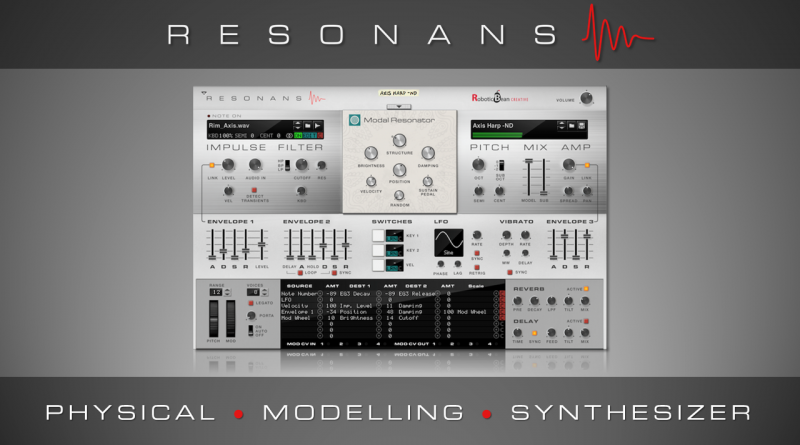Robotic Bean presents Resonans, Reason’s first physical modelling synthesizer!
We are excited to report that in the form of Resonans by Robotic Bean a new type of synthesis is arrived to Propellerhead Reason! In addition, we are happy to announce that we have partnered with Robotic Bean for a Resonans song challenge. Further information will be posted here.
Crash introduction to physical modelling synthesis
As physical modelling synthesis is new to Reason let’s lay down the basics of this kind of sound generation. In physical modelling synthesis, the physical properties of a sound source called the resonator, for example a string, is described with mathematical equations. In order to produce sound with such a resonator, in our example a string, it has to be plucked or bowed i.e. excited just like a real string. The dynamic and sonic properties of the exciter impulse will greatly affect the generated sound thus providing the ability to mimic the different ways one can interact with an instrument.
Introducing Resonans
Resonans physical modelling synthesizer follows the same principles described above. It has an exciter called Impulse and two plus one resonators labelled as Model, see the image. The two resonators are the Modal Resonator and the Inharmonic String, while the extra resonator is actually a bypass mode letting through the exciter signal untouched. To help strengthen the fundamental frequency of the sound and give it more bottom end Resonans has a built-in sub oscillator.
- 2 physical models: Modal Resonator and Inharmonic String
- Noise generator and sampler
- Live audio input with transient detector
- Multimode state variable filter with Lowpass, Bandpass and Highpass modes
- Sub oscillator
- 3 envelope generators
- LFO and Vibrato
- 2 key switches and a velocity switch, with MIDI Learn
- Trigger inputs for the key switches
- Modulation matrix with nested menus and drag & drop
- 4 assignable modulation CV inputs and outputs
- Reverb and delay with tilt EQ
- Stereo FX audio input
- Full Remote and automation support
- Over 200 patches by renowned sound designers
Diving into Resonans
Sound engine
Exciter options
Resonans have plenty of options when it comes to exciters. By default one can use the traditional way of exciting a resonator i.e. feeding it with bursts of white noise. But Robotic Bean took the extra mile and added two more interesting exciter options such as Sample loading and live Audio input opening up endless possibilities. Before reaching the physical model the exciter signal may be shaped to taste by an envelope and a multimode filter.
A closer look at the resonators
Both Models i.e. Modal Resonator and Inharmonic String have two sets of rotaries. The four big rotaries can be used to tweak the inner workings of the resonators, while the other three is there to help producing a constantly evolving sound. The Structure knob sets the harmonic structure and complexity of the sound. At higher values the resonator will produce timbres that sound glassy or metal. The Position knob controls the exciter-resonator interaction by determining at which point the impulse is applied on the string or the surface in he case of Inharmonic String and Modal Resonator, respectivly. The Brightness and Damping knobs are affecting the timbre and length of the sustain of the sound. As said above Resonans has a built-in sub oscillator that always follows the frequency and amplitude of the physical model.
Effects
Resonans comes with simple looking yet powerful built-in Reverb and Delay. Both effects have a Tilt EQ that can make them shimmer or rumble as you wish. In the Reverb at positive settings the signal goes through a HP filter, gradually increasing the cutoff frequency, resulting in a more “shimmering” reverb. At negative settings, a LP filter is used with a gradually decreasing cutoff frequency, resulting in a more subdued reverb. The tilt control of the Delay is very similar to the Reverb`s. But there’s one important difference: In the Delay, the filter is inside the feedback loop of the delay itself, resulting in a more heavily filtered sound for each echo.
Modulation options
Reasonans has a powerhouse of modulation options. Its Modulation bus has a standard Source → Destination 1 → Destination 2 → Scale type structure with 8 rows with the popular drag and drop routing for each destination and source slots and buttons to clear entire rows of settings. Due to the clever move of including LEDs for them at the bottom of the Modulation bus one can even utilise the drag and drop routing method with the freely assignable modulation CV Inputs and Outputs.
In addition, Resonans has three Envelopes, two LFOs and some interesting Switches. Two of these switches labelled with Key may be triggered by user definable MIDI notes. The third Switch (Vel) is activated when the incoming note`s velocity is equal or higher than the defined threshold. One can trigger the Switches by
- pressing the configured key or cross the configured threshold,
- pressing the button,
- sending a positive CV signal to the corresponding input on the back
Summary
Resonans by Robotic Bean brings a new type of synthesis to the Reason Rack with a wast amount exciter options and modulations to achieve interesting sounds from percussion to evolving pads. Don`t forget to follow Robotic Bean on social media and subscribe to the Robotic Bean Newsletter.
Resonans Physical Synthesizer. Get physical modelling synthesis in your Reason rack today!
Introduction price during May: 89 €/$ (25% off)
Price: 119 €/$
Available in the Propellerhead shop.

